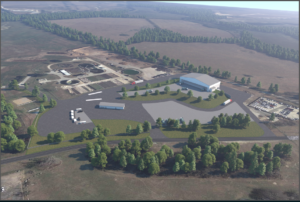New Georgetown Transfer Station
At the February 28, 2023 council meeting, City Council approved a contract with Novak Commercial Construction, LLC of Georgetown, TX to construct the new transfer station. Construction began on April 24, 2023 and is expected to be completed within 18-24 months. During this time the site will remain fully operational.
Why does Georgetown need a transfer station?
The Georgetown Transfer Station, located at 250 W. L Walden Drive, provides a cost-effective, efficient method for managing our waste by reducing the number of collection trucks on the roads. Once a collection truck is filled, it goes to the transfer station to empty its load, then back out to finish the route. Without the transfer station, the truck would have to go directly to the landfill, which is about 90 miles away. This increases the number of trucks needed to complete the same number of collections, thus increasing the residential rate. Additionally, fewer trucks on City streets reduces wear and tear, traffic congestion, and residents intermingling with larger vehicles.
The transfer station allows residents to:
-
-
- Recycle at no charge
- Request bulky waste pickups at no additional cost 4x/year. See Bulk Waste Disposal for further information
- Obtain free mulch for landscaping. See Yard Trimmings for further information. **Due to the construction currently taking place at the transfer station, the free mulch program has been put on HOLD. The program will resume when construction is complete. **
- Recycle Christmas Trees and holiday string lights free of charge
- Drop off tires, mattresses, fryer grease, and many other items for a fee
-
Why does the Transfer Station need improvements?
The transfer station was built in 1984 when Georgetown’s population was almost 10,000 people. At that time, the City anticipated the transfer station would last until the year 2000 and be able to manage the waste of at least 16,000 residents before an upgrade was needed. The most recent facility improvements were made between 2006 & 2009. The transfer station is now managing the waste of nearly 80,000 residents and those numbers are expected to continue to increase.
In 2018, the City committed to the Texas Commission on Environmental Quality (TCEQ) to make certain improvements as the transfer station which include covering areas where waste is exposed and better stormwater management. These improvements will meet the minimum state regulations for health and safety.
By improving the transfer station, the City increases efficiency, as well as increases the services offered to residents, such as household hazardous waste collection and compost. The improvements will also allow the transfer station to generate additional revenue, which is currently $200,000+ per year.
What is the overall cost of the construction, and why is the City paying instead of Texas Disposal Systems?
The transfer station improvements will cost about $15 million, and will be paid over the course of 20 years. Since the transfer station is a City asset, the City is updating its property. TDS operates the transfer station for the City.
What improvements are being made to the transfer station?
-
- Provide for 3 waste streams (trash, recycle & compost), with less down time to process multiple streams
- Increase operational efficiency
- Meet state regulations for health and safety
- Reduce wait times to unload vehicles by creating separate roads for residential & commercial truck traffic
- Upgrades to the residential recycling and drop-off areas
- Installation of a truck/vehicle wash bay for all City vehicles
- Regrading the landscape to better direct water to the stormwater pond, prevent standing water on the old landfill, and prevent overflow to the San Gabriel River.
New Transfer Station Rendering









